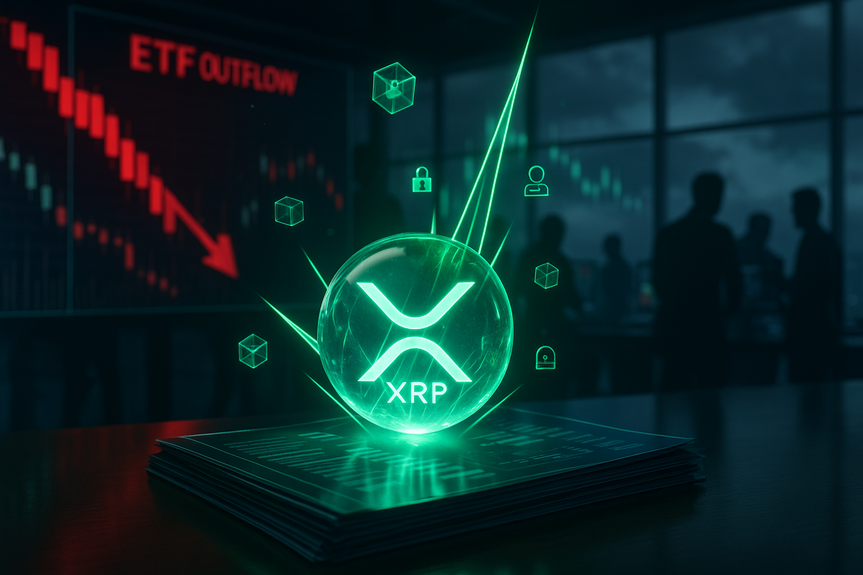XRP ETF inflows 2025 guide traders to pinpoint technical profit signals and actionable entry points.
XRP ETF inflows 2025 are drawing attention as institutions rotate away from BTC and ETH products. This guide shows how to read the flow data, link it to price and liquidity, and spot potential profit signals. Learn the key catalysts, the technical triggers, and the risks that matter right now.
A sharp shift in capital often starts quietly, then shows up in numbers. Recent reporting points to heavy outflows from Bitcoin and Ethereum ETFs in a single day, while new XRP products gained traction. XRP price bounced back above the $2.00 mark and touched about $2.24 as inflows and trading volumes rose. This rotation hints at a new institutional playbook. It also raises a practical question: how do you turn these flows into a clear, repeatable strategy?
Below, you find a simple framework. It connects ETF flow data, price action, and upcoming catalysts on the XRP Ledger. You will see what to watch, how to confirm setups, and where the thesis can fail. The goal is clarity. Keep it simple. Follow the money. Respect risk.
XRP ETF inflows 2025: Signals that matter
Follow the money first
When capital moves into an exchange-traded product, it leaves a trail in daily creations and redemptions. That trail often leads price. Reports show:
Bitcoin spot ETFs saw net outflows near $903 million on a single day in late November.
Ethereum ETFs lost around $261 million in the same window.
The leading BTC ETF had its weakest month since launch, with more than $2.1 billion in redemptions in November.
By contrast, new XRP ETFs drew inflows and strong early trading. One product reportedly hit about $22 million in volume within hours of its U.S. listing. Canary Capital and Bitwise were mentioned among early issuers. This split suggests investors are rotating, not just exiting the market.
Practical takeaway:
Track daily net flows. Green flows into XRP with red flows out of BTC/ETH can mark an early rotation.
Confirm that flows persist for several sessions. One day is noise; a week builds a trend.
Compare flows to float size and average volume to judge impact.
Volume and liquidity confirm the story
Flows mean little without liquidity. Watch:
Trading volume spikes in the ETF and the underlying spot XRP pairs.
Bid-ask spreads. Tight spreads signal healthy two-way markets.
Intraday depth. Can markets absorb large orders without big price gaps?
If XRP ETF inflows 2025 push volume up while spreads stay tight, the move is more likely to stick. If spreads widen as price jumps, be careful. Thin rallies often fade.
Price reclaims key levels
Price gives the final say. The recent case is clear: XRP fell below $2.00 for four days, then reclaimed that level and rallied toward $2.24 as inflows came in. That is a classic “break and reclaim” setup. It tells you dip buyers won the level back.
Use simple levels:
$2.00 as a line in the sand for momentum in this cycle.
Recent swing highs and lows to set targets and stops.
A daily close back above a lost level as confirmation, not just an intraday wick.
What drove the rotation while BTC and ETH saw outflows
Risk control and rebalancing
Institutions often cut exposure when prices fall fast. Reports show BTC slipped below $82,000 and ETH below $2,800 during heavy ETF outflows. That fits a typical pattern:
De-risk into cash or rotate into assets with new catalysts.
Harvest profits after a long run-up.
Rebalance to target weights before month-end or year-end.
At the same time, fresh XRP products gave allocators a clean wrapper to test. That wrapper lowers operational friction. It fits existing mandates better than direct token custody. A small slice can seek alpha without overhauling policy.
New supply and fresh demand
When a new ETF launches, market makers create shares and build inventory. That activity can lift early volumes and attract momentum traders. In XRP’s case, the first sessions saw strong turnover and price strength while other majors dipped. That divergence draws attention, which can add more flow. It becomes a loop: flows drive interest, interest drives flows.
On-chain and product catalysts to watch in 2025
Native staking proposal for XRPL
Ripple leaders have discussed adding native staking to the XRP Ledger to improve incentives and network security. The head of engineering at RippleX noted that staking could solve gaps not covered by fee burning. There is no firm timeline, but the idea is part of a broader plan to upgrade consensus and attract DeFi builders.
Why it matters:
Staking can tighten effective float if holders lock tokens.
Yield can draw long-term capital and reduce sell pressure.
Better security and incentives can attract apps and liquidity.
Staking-like yields and liquid staking
Even without native staking, third-party platforms already offer staking-like returns on XRP. Projects on Flare and other networks are piloting liquid staking tokens that bring XRP into DeFi. If these models scale safely, they add utility and new demand paths.
ETF access for traditional buyers
With XRP ETFs now available in some markets, pension funds and financial advisors can consider small positions within existing rules. A more favorable regulatory stance, plus Ripple’s recent legal progress, could speed that process. The net result is more doors for capital to enter, even if each door opens only a little at a time.
A practical checklist to trade inflow-driven setups
1) Start with flows
Check daily creations/redemptions for XRP, BTC, and ETH ETFs.
Mark three-day and five-day totals to see trend persistence.
Note whether flows align with price direction or diverge.
2) Confirm with liquidity
Watch ETF volume versus its 10-day average.
Check spot XRP volumes on major exchanges.
Look at spreads. Tight spreads and rising volume are healthy.
3) Use simple technicals
Reports pointed to RSI approaching oversold when XRP reclaimed $2.00. Meanwhile, MACD still showed selling pressure. That mix says “early turn, but not confirmed.” Combine:
RSI near 30–40 with levels reclaimed as a first signal.
MACD cross or histogram improvement as a second signal.
Higher highs and higher lows on the 4-hour or daily chart as final confirmation.
4) Cross-check derivatives
Open interest rose as price turned up. That suggests traders re-entered. Still, you should ask: are longs chasing or is it balanced?
Open interest rising with steady funding can be healthy.
Extreme positive funding can warn of crowded longs.
Rising OI plus falling price may hint at shorts. Do not fight that without a clear level reclaim.
5) Plan the trade
Entry: After a daily close back above a key level like $2.00 with supportive flows.
Stop: Just below the reclaimed level to avoid deep drawdowns.
Targets: Prior swing highs, then measured moves based on range size.
Size: Keep risk small per trade. Position sizing beats perfect timing.
Technical snapshot: what the chart hinted during rotation
Recent reporting outlines a constructive but cautious setup:
Price fell under $2.00 for four days, then reclaimed it and ran toward $2.24.
RSI approached oversold, a common spot for bounces to start.
Open interest moved higher, signaling renewed participation.
MACD still showed a sell trend, a reminder that the larger down move may not be finished.
How to read it:
Bull case: ETF inflows persist, price holds above $2.00, MACD improves, and higher lows form. Confirmation arrives on a daily close above the next swing high.
Bear case: Price loses $2.00 again on volume while flows fade. That likely starts another leg down or a longer range.
The simple rule stands: flows plus reclaimed levels define the trade. Lose either one, and the setup weakens.
Risks that could invalidate the thesis
Macro and liquidity shocks
A sudden risk-off event can force redemptions across all crypto ETFs. If funding conditions tighten or equities fall sharply, even strong narratives face selling.
Regulatory turns
Policy shifts can change access for ETFs, advisors, or platforms. A slower or stricter stance reduces the pool of potential buyers and delays approvals or listings.
Product concentration
If one large issuer sees redemptions, it can swing the daily flow numbers. Do not anchor on a single product. Track the basket.
On-chain weak spots
Reports note that many XRP addresses may be at a loss at current prices. Holders at a loss often sell into strength, which can cap rallies. Until staking or new utility absorbs supply, rallies can remain choppy.
How to track XRP ETF inflows 2025 fast
Daily flow data
Check issuer websites for creations/redemptions updates.
Use respected market data dashboards that summarize ETF flows by day.
Follow weekly digital asset fund flow reports from research firms to see broader trends.
Volume, spreads, and depth
Monitor ETF volume during the first and last hour of trading.
Watch spot XRP pairs on top exchanges for volume surges and spread changes.
Compare current volume to the 10-day average to spot regime shifts.
Derivatives and funding
Track open interest on major futures venues.
Watch funding rates and basis to gauge positioning.
Look for divergence: rising OI with rising price is often constructive; rising OI with falling price can signal pressure.
Catalyst calendar
Follow updates on XRPL staking proposals or testnets.
Watch for new ETF listings, ticker additions on big exchanges, or coverage by more brokers.
Track legal or regulatory headlines that can expand or shrink the buyer base.
Putting it all together
XRP ETF inflows 2025 have turned a quiet idea into a tradable narrative. The process is simple but strict. Start with flows. Confirm with liquidity. Demand price to reclaim and hold key levels. Use derivatives to read positioning. Keep an eye on catalysts like native staking and DeFi integrations. Respect the bear case if $2.00 fails again or flows fade.
When XRP ETF inflows 2025 accelerate while BTC and ETH products bleed, the rotation is real. When volume and spreads confirm, the move is healthy. When price closes back above key support, entries make sense. And when MACD and structure improve, conviction grows. Until then, stay humble, size small, and let the data lead.
None of this is financial advice. Markets change. Plans should adapt. If the flows stop or the thesis breaks, exit and wait for the next clear signal. Profit comes from patience, discipline, and a repeatable process. If XRP ETF inflows 2025 keep building and the network’s utility expands, the odds of finding those signals improve.
(Source: https://www.bitget.com/news/detail/12560605082414)
For more news: Click Here
FAQ
Q: What are XRP ETF inflows 2025 and why do they matter?
A: They refer to capital moving into exchange-traded products for XRP during 2025, signaling an institutional rotation away from BTC and ETH products reported in late November. These inflows matter because the article links them to price rebounds above $2.00, rising trading volumes, and a potential change in how institutions allocate crypto capital.
Q: How did XRP ETFs perform compared with BTC and ETH ETFs during the recent outflows?
A: Spot Bitcoin ETFs registered about $903 million in net outflows on Nov. 20 while Ethereum ETFs lost around $261 million in the same window, and the leading BTC ETF saw more than $2.1 billion pulled in November. By contrast, new XRP ETFs drew inflows and one product reportedly reached about $22 million in trading volume within hours, helping XRP reclaim the $2.00 level and run toward $2.24.
Q: What signals should traders watch to confirm XRP ETF inflows 2025 are genuine?
A: Start with daily creations and redemptions for XRP, BTC, and ETH ETFs and look for persistence over several sessions rather than a single-day spike; for XRP ETF inflows 2025 specifically, confirm rising ETF and spot trading volume, tight bid-ask spreads, and healthy intraday depth. Finally, require price to close back above key levels like $2.00 as confirmation before treating inflows as durable.
Q: How could XRPL staking proposals influence ETF inflows and XRP demand?
A: Ripple has discussed adding native staking to the XRP Ledger, which could tighten effective float if holders lock tokens and attract DeFi builders, but there is no set timeline for implementation. In the meantime, third-party staking-like returns and pilots for liquid staking on Flare provide yield paths that may draw longer-term capital.
Q: Which technical indicators accompanied the recent XRP rotation and what did they show?
A: The price fell below $2.00 for four days then reclaimed that level and moved toward $2.24, while RSI approached oversold—a common spot for bounces—and open interest increased, suggesting renewed participation. At the same time the MACD still showed selling pressure, indicating the larger downtrend may not be finished without further confirmation.
Q: What risks could invalidate an inflow-driven trading thesis for XRP?
A: Macro liquidity shocks or sudden risk-off events can force redemptions across all crypto ETFs and reverse flows, and regulatory shifts can restrict access or slow ETF adoption. Product concentration and on-chain weaknesses—such as many XRP addresses currently at a loss that may sell into strength—are additional risks that can cap rallies.
Q: How does the article recommend planning entries, stops, and position size around ETF-driven setups?
A: The suggested plan is to enter after a daily close back above a reclaimed level like $2.00 with supportive flows, place stops just below that level to limit drawdowns, and set targets at prior swing highs. Position size should remain small relative to account risk and be guided by risk management rather than timing alone.
Q: What are the fastest ways to monitor XRP ETF inflows 2025 in real time?
A: To track XRP ETF inflows 2025 quickly, check issuer websites for creations and redemptions updates and use market data dashboards that summarize daily ETF flows and weekly fund flow reports from research firms. Also monitor ETF and spot volumes, bid-ask spreads, open interest and funding rates on derivatives venues, and follow a catalyst calendar for XRPL staking proposals and new ETF listings.







